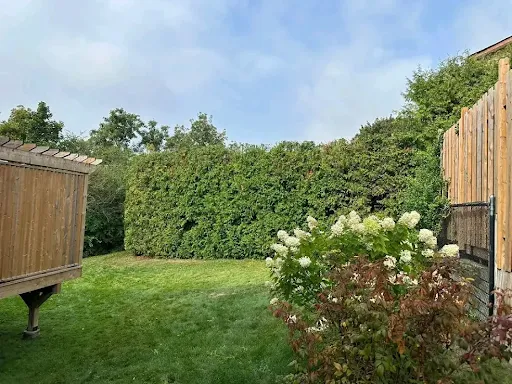
Garden Hedge Trimming Service: Professional Tips for a Polished and Healthy Landscape
A garden is more than just an outdoor space; it is a reflection of the care, creativity, and personality of the homeowner. While flowers bring colour and trees add grandeur, hedges and shrubs provide the structure and definition that tie the entire landscape together. However, without regular care, even the most beautiful shrubs can become unruly, and hedges can lose their sharp lines and polished appearance. That’s why garden hedge trimming services and thoughtful landscaping trimming shrubs practices are essential for anyone who wants a neat, healthy, and visually appealing outdoor area.
Trimming not only enhances the look of your garden but also improves plant health, encourages fresh growth, and prevents pests from settling in. Below, we’ll explore the best techniques and practical tips for hedge and shrub trimming that will keep your landscape looking crisp and well-maintained all year round.
Why Hedge and Shrub Trimming Matters
Before diving into the techniques, it’s essential to understand why trimming is so vital:
Promotes Plant Health: Removing dead or diseased branches helps shrubs direct their energy toward healthy growth.
Improves Shape and Structure: Regular trimming helps maintain the design of your garden, whether formal or casual.
Boosts Curb Appeal: Neatly cut hedges give your property a polished, well-kept look.
Prevents Overgrowth: Without trimming, shrubs can shade out other plants, spread unevenly, or grow weak lower branches.
Encourages Longevity: Healthy trimming extends the life of plants, keeping them strong and vibrant for years to come.
Trimming is a combination of both art and science, as it involves balancing the visual appeal of the plants with their care needs.
Top Tips for Garden Hedge Trimming and Shrub Care
1. Trim at the Right Time of Year
Plants behave differently depending on the season. Knowing when to trim ensures that your shrubs and hedges thrive without being stressed.
Spring: Remove winter damage and lightly shape new growth. This is also a great time to encourage fuller foliage.
Summer: Perform light trims to control fast-growing shrubs without overcutting.
Autumn: Focus on clearing deadwood and preparing plants for the cold season.
Winter: Since most plants are dormant, this is the best time for structural pruning.
Hiring a garden hedge trimming service often ensures that seasonal schedules are followed, protecting the health of each plant variety.
2. Invest in the Right Tools
The quality of your tools can make or break your trimming results. Sharp shears, hedge trimmers, and loppers deliver clean cuts, while dull tools tear branches, increasing the risk of disease.
Always disinfect tools before moving from one plant to another.
Choose high-quality trimmers with adjustable blades for flexibility.
Keep tools well-oiled and sharpened to extend their lifespan.
This simple investment in good equipment leads to healthier plants and more efficient trimming.
3. Follow the One-Third Rule
When landscaping, avoid over-pruning when trimming shrubs. Cutting more than one-third of a plant’s growth at once can shock it, slowing recovery and leaving it vulnerable to pests and disease.
Instead:
Trim gradually, step back often, and assess the shape.
Prioritize balance and proportion rather than aggressive cutting.
Remember, taking a slow and steady approach will result in healthier shrubs and more consistent growth.
4. Begin With Dead or Diseased Growth
Always start by removing damaged branches. Broken, diseased, or insect-infested wood not only weakens plants but also spreads problems to nearby shrubs. Once cleared, you’ll have a cleaner base to work with and can shape the healthy branches effectively.
5. Define Garden Borders for a Clean Look
One of the easiest ways to make a garden look professional is by maintaining crisp edges. Create a clear separation between hedges, lawns, and pathways using a manual edger or string trimmer. A clean border enhances the trimmed look of shrubs and ties your garden design together.
Tip: Monthly edging during the growing season keeps borders sharp and defined.
6. Trim for Natural Shape and Design
Not every shrub or hedge should look like a perfect box. While geometric designs work well in modern landscapes, natural gardens benefit from softer curves and flowing forms.
Formal Gardens: Straight lines, square shapes, and flat tops.
Casual Gardens: Rounded edges, varying heights, and asymmetrical designs.
Mixed Landscapes: Combine structured hedges with naturally shaped shrubs for balance.
A professional garden hedge trimming service can advise on the best style for your specific landscape theme.
7. Keep Lower Growth Full and Healthy
One common mistake when landscaping trimming shrubs is cutting away too much at the bottom. This causes weak lower branches and a thin, uneven look.
The solution:
Trim in a tapered style, slightly wider at the base than the top.
This allows sunlight to reach all levels, keeping foliage full and strong.
The result is a lush, vibrant hedge that looks healthy from top to bottom.
8. Stick to a Routine
Consistency is key. A one-time heavy trim can’t replace the benefits of regular maintenance.
Light trimming: every few weeks during peak growth.
Seasonal trimming: four times a year to match plant cycles.
Professional check-ups: once or twice a year for large-scale corrections.
If time is limited, outsourcing to a garden hedge trimming service ensures your outdoor space never falls into disarray.
9. Add Mulch After Every Trim
Mulching is a finishing touch that not only enhances the appearance but also benefits plant health. After trimming:
Spread mulch around the base of hedges and shrubs.
Choose natural mulch like bark, pine needles, or shredded leaves.
Mulch retains soil moisture, prevents weeds, and enriches soil nutrients.
Think of it as both practical care and a visual polish for your garden beds.
10. Know When to Call the Experts
Some jobs are best left to professionals. Tall hedges, large shrubs, or tricky areas near fences and walls can be difficult and unsafe without proper tools and training.
A professional garden hedge trimming service brings:
Expertise in shaping different plant varieties.
Specialized equipment for safe and precise work.
Knowledge to spot early signs of disease or pest problems.
Hiring experts not only saves time and effort but also ensures your garden’s long-term health.
Additional Tips for Stunning Hedges and Shrubs
Choose the Right Shrub Varieties: Some plants respond better to trimming than others. Boxwood, privet, and holly are great hedge choices.
Water properly: Trimmed plants may need extra hydration to recover quickly.
Fertilize Wisely: After trimming, a balanced fertilizer can boost regrowth.
Mix Heights: Alternate tall hedges with medium shrubs to create depth in the landscape.
Combine Function with Beauty: Hedges can serve as privacy screens, windbreaks, or decorative features.
Final Thoughts
A beautifully trimmed garden reflects discipline, creativity, and attention to detail. Whether you manage your shrubs yourself or hire a garden hedge trimming service, the results speak for themselves: neat lines, healthy plants, and a landscape that feels welcoming and balanced.
With proper landscaping trimming shrubs practices, your outdoor space won’t just look tidy, it will thrive season after season, offering both curb appeal and a calming environment for you to enjoy.
